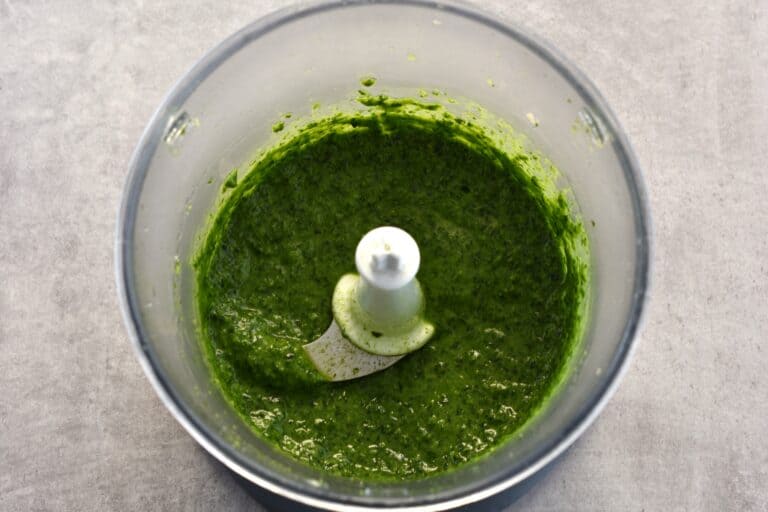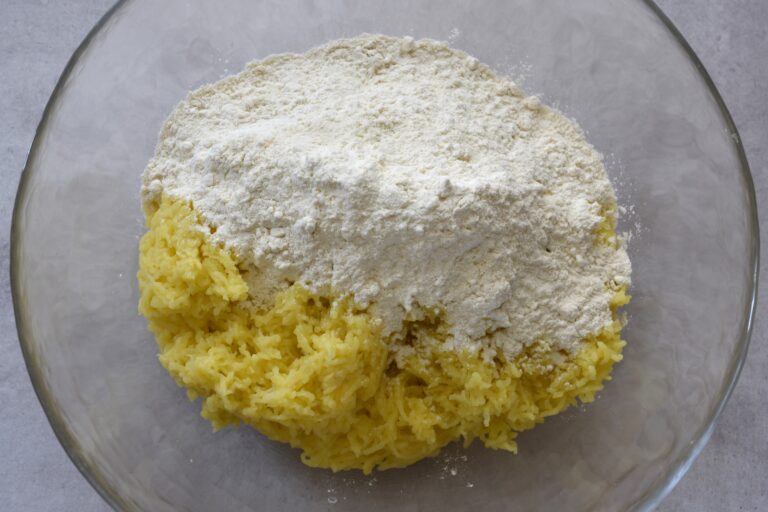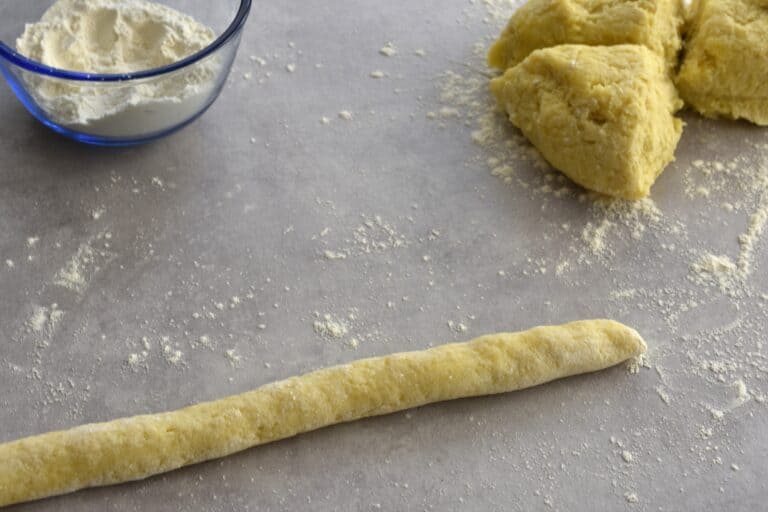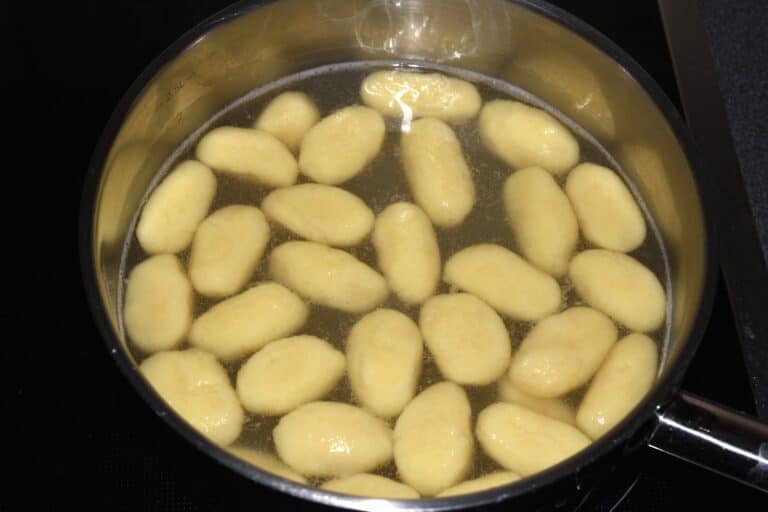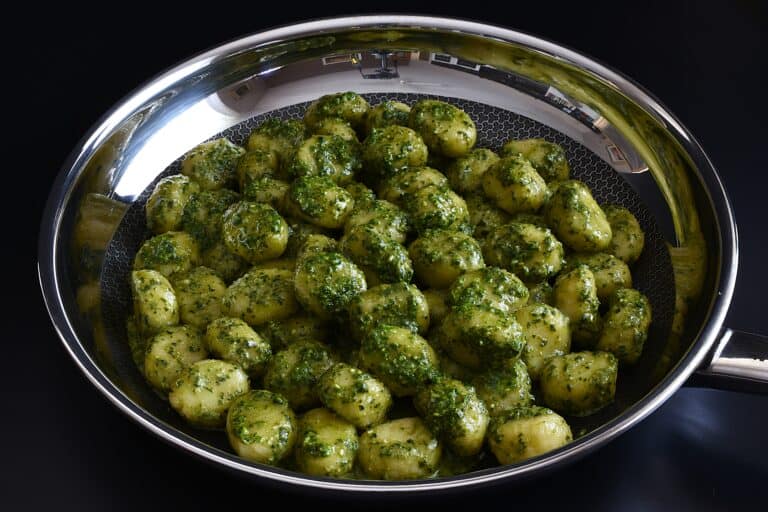Homemade vegan potato gnocchi with basil pesto is a festive alternative to simple pasta with pesto. Known as gnocchi al pesto genovese in Italy, or simply gnocchi alla genovese, it’s often served on Sundays and special occasions. Fragrant homemade basil pesto is the perfect accompaniment for tender, melt-in-the-mouth potato gnocchi. They complement each other perfectly. These homemade potato gnocchi are made without eggs. They’re light, fluffy, and will never stick to your palate.
More and more people are discovering the joys of making homemade gnocchi. It’s a dish that brings people together. Creating gnocchi from scratch with family or friends is a beautiful reminder of the simple pleasures in life – taking the time to cook, share, and enjoy delicious food.

If you’re looking for a quick midweek meal, you can opt for ready-made vegan gnocchi and pesto. It’s not as good as homemade, but it makes a tasty, easy dinner nonetheless. Check the labels, though, because sometimes gnocchi contain eggs, and most pesto will have cheese in it unless it’s labelled vegan.
Pesto Genovese, hailing from Genoa in Italy’s Liguria region, is a sauce bursting with summer flavours. Made from fresh basil, garlic, pine nuts, and olive oil, it’s traditionally combined with Parmesan cheese or Pecorino. In this vegan version, we’ll be using nutritional yeast to impart that cheesy, umami flavour. The result is a pesto that is just as rich and aromatic as the original, ready to be paired with your delicious homemade vegan potato gnocchi!

How to make Homemade vegan potato gnocchi with basil pesto
Making your own vegan potato gnocchi for family or friends is really rewarding, but potentially, there are lots of things that can go wrong, leading to disappointing results. I recommend you follow the indications below to the letter, especially if you are new to gnocchi making. If you do, you will get it right.
If you have any questions or doubts about the ingredients and instructions below, just click on How to make perfect vegan potato gnocchi and Vegan basil pesto genovese. These links will take you to recipes that go into much greater detail. Google doesn’t like duplicate content, so I’d probably be penalised if I repeated every single thing here.
Ingredients
The exact quantities of each ingredient are indicated in the recipe card at the bottom of this page.
For the potato gnocchi
FLOUR
Plain (all-purpose) white flour is perfect for making potato gnocchi. If you use a different type of flour, you may need to adjust the quantity slightly.
POTATOES
For gnocchi, you’ll need potatoes with a high starch and low water content. Choose starchy varieties like Russet or Yukon Gold potatoes. Maris Piper and King Edward in the UK. If you live in Switzerland, you need the blue bag at the Coop or Migros (with the wording mehligkochend or farinose).
Old (mature) potatoes are ideal for making gnocchi. They are starchier and tend to break up easily (that’s why they’re boiled in their skins, so you get the farinaceous texture without them breaking up). Don’t use new potatoes because they have a higher water content and remain firm when cooked.
SALT
Salt causes vegetables to leak water due to osmosis. For this reason, we won’t be adding salt to the gnocchi dough – only to the cooking water. Remember to simmer the potatoes in well-salted water. The finished gnocchi are also cooked in salted water.

For the dairy-free pesto genovese
Basil
Only use fresh basil leaves for making pesto. When buying basil for pesto, it’s essential to choose very fresh, high–quality basil leaves to ensure the best flavour and aroma in your sauce. Fresh basil should look lush and vibrantly green.
Pine nuts
Pine nuts are the classic choice for traditional Genovese pesto. These tiny little nuts have a mild, slightly sweet, and buttery flavour that is subtle yet distinctive. When ground, they become creamy, which makes them perfect for pestos. If you need an alternative due to allergies or availability, there are several nuts and seeds you can use to make a tasty pesto variation. Some popular options include walnuts, pistachio nuts, almonds, cashews, pecans and sunflower seeds. When substituting nuts or seeds in pesto, bear in mind that the flavour and texture of your pesto will vary based on the choice you make.
Oil
This is not a recipe where you can skimp on the oil and get away with it. Go for the best extra virgin olive oil you can find. Ideally, it should be organic, cold-pressed, and fragrant.
Garlic
Look for fresh bulbs with firm cloves. Avoid garlic bulbs that feel soft or have started sprouting. The papery skin should be dry and tight. After you have removed the skin, the clove of garlic should be almost white. Don’t use discoloured, wizened cloves. You can adjust the quantity of garlic in your pesto based on your personal taste. Start with a moderate amount and add more if needed after tasting the pesto.
Mince the garlic beforehand, even if it is going in the food processor anyway. This allows its oils to infuse the pesto, enhancing its overall taste.
Lemon juice
Use only freshly squeezed lemon juice in basil pesto. One teaspoon of lemon juice per 50 g of basil leaves is sufficient to prevent your pesto from oxidising and turning brown.
Salt
You’ll need fine rather than coarse salt for this pesto genovese. I use natural, unrefined grey sea salt in all my recipes.
Nutritional yeast flakes
Nutritional yeast flakes provide the cheesy flavour in this dairy-free basil pesto. Make sure you use nutritional yeast flakes and not powder.
Vegan parmesan cheese
I recommend using homemade vegan parmesan cheese for this recipe. My recipe takes less than 5 minutes to make and uses just 4 ingredients: raw cashew nuts, raw almonds, nutritional yeast and salt.

How to make vegan pesto gnocchi
Instructions
You’ll find step-by-step instructions with photos in the recipe card at the bottom of this page. In short, you’ll make the pesto while the potatoes are simmering, then proceed with the gnocchi.
Make the pesto
- Place half of the basil leaves in the blender of a food processor, along with the pine nuts, extra virgin olive oil, garlic, salt, and lemon juice.
- Blend until the basil leaves are roughly chopped. Then, add the rest of the basil leaves and continue blending until smooth.
- Add the nutritional yeast flakes and vegan parmesan cheese and blend again briefly to amalgamate.
- This step is optional but recommended. Using a spatula, scrape the pesto out of the food processor and transfer it to a mortar. Begin emulsifying the pesto with the pestle, using a gentle and prolonged rotary motion against the bottom and walls of the mortar. Continue like this for 5 – 10 minutes until the pesto is creamy, smooth, and emulsified.
Make the gnocchi
Boil the potatoes
- Choose potatoes of a similar size and simmer them in abundantly salted water with the skins on. Always put potatoes in cold water and bring to a boil slowly. After 30 minutes, from when the water starts to boil (40 mins for very large potatoes), put a knife through one of the potatoes to see whether it’s cooked. Don’t randomly stab all your potatoes – it lets water in! When one is cooked, they all are. Once they are done, drain them and leave them to steam dry in a colander.
- As soon as the potatoes have dried off and are cool enough to handle, peel them.
Rice the potatoes
Put the potatoes through a ricer or vegetable mill (mouli) while they are still warm. Whatever you do, don’t use a blender or food processor for the potatoes! This makes them gooey and glutinous. If you only have a masher, you might get half-decent results if you use starchy potatoes and don’t over-mash them. Consider investing in a good ricer or vegetable mill (mouli) – you won’t regret it!
Add the flour
- Add the flour once the potatoes have cooled down. Hot mashed potato activates the gluten in the flour and changes the consistency of the gnocchi dough, making it gooey. Amalgamate the mixture with your hands or a wooden spoon without overworking it so you have a homogeneous, slightly sticky, but workable dough. If necessary, add some more flour.
Shape the gnocchi
- When you’re happy with the consistency, sprinkle a generous amount of flour on the worktop and roll the gnocchi dough into long snakes the thickness of a standard sausage.
- Cut the snakes crosswise into lengths of about 1,5 cm. Make sure they are well coated in flour. Shape the pieces in your hands into the desired gnocchi shape.
Cook the potato gnocchi
- Bring a pan of salted water to a boil. Drop the gnocchi into the boiling water in batches, aiming for a single layer on the bottom of the pan. Adjust the heat so that the water is constantly simmering but not boiling furiously.
- After a minute or so, the gnocchi will start to rise to the surface and float – this means they are cooked. Scoop them out with a slotted spoon as soon as they come to the surface. Continue adding raw gnocchi to the pan of simmering water to replace the ones you have taken out.
Add the pesto
- Stir in the basil pesto until the gnocchi are well coated. Use a soft spatula to do this – that way, you won’t break them up as you turn them. Remove the pan from the heat to do this because heat will cook the basil and dull the colour and flavour. If the pesto is a bit thick, add a spoonful or two of the cooking water until you reach the desired consistency.
- Transfer the gnocchi to a serving dish or individual plates and garnish with a few leaves of fresh basil.

How to serve vegan pesto gnocchi
Serve your vegan pesto gnocchi immediately with optional vegan parmesan cheese.
I love making tris di gnocchi, which is basically a lot of gnocchi served with three different sauces, where everyone around the table helps themselves to the gnocchi with the sauce or sauces they fancy. In the summer, these are usually seasonal sauces like fresh tomato pasta sauce with fresh basil, melted vegan butter with sage and, of course, vegan pesto Genovese.


There are lots of other seasonal variations, like porcini mushrooms in the autumn, wild garlic in the spring, and artichokes in the winter. Potato gnocchi are a very versatile, year-round dish that everyone loves!
You can serve vegan pesto gnocchi as a main course or a first course. In Italy, gnocchi is usually considered a first course and would be followed by a main course of vegetables and some kind of protein. I recommend a main course like seitan and roasted vegetable skewers, stuffed courgettes or aubergines, vegan polpettone with spinach, or aubergine parmigiana.
How to store potato gnocchi and basil pesto
If you make a large batch of gnocchi, the best way to store them is to freeze them (see the next paragraph).
If you have leftover cooked gnocchi, I recommend storing the pesto and the gnocchi separately. Put the gnocchi into a container and drizzle a small amount of olive oil over them to prevent them from sticking together. Put a lid on the container and store the gnocchi in the fridge.
Store any leftover basil pesto in a jar with a thin layer of oil over the top. Put a lid on the jar – it will keep in the fridge for more than a week. Remember to flatten the surface and replenish the oil every time you take some pesto out of the jar.
Unfortunately, it isn’t really possible to store raw gnocchi in the fridge. They quickly become gooey and stick together. Even if you space them out and keep them flat, they’ll end up sticking to the surface and the texture and appearance will change within a matter of hours. When potatoes are exposed to air, their starches tend to oxidise, which will cause the gnocchi to take on an unattractive greyish tinge.
Can you freeze potato gnocchi and vegan basil pesto?
As above, I recommend freezing the pesto and the gnocchi separately. It’s best to freeze them raw, as soon as you’ve finished making them. You can freeze cooked gnocchi but freezing will affect the texture and make them mushier. For the best results, freeze raw gnocchi flat, in a single layer. Once frozen, tip them into a ziplock freezer bag to save space.
Ideally, freeze the pesto in portions. That way, you can defrost just the amount you need each time. There are silicone moulds that are perfect for freezing small amounts of food in cubes. Again, once frozen, you can put the cubes of pesto into a freezer bag to free up the container for other things.
How to reheat
To reheat cooked gnocchi, put them gnocchi in a wide, non-stick pan. Add a tablespoon of water or oil to prevent the gnocchi from sticking. Cover the pan with a lid and reheat the gnocchi slowly on low heat. Alternatively, you could heat them up in the microwave.
To reheat cooked gnocchi from frozen, allow the gnocchi and the pesto to defrost at room temperature before proceeding as above.
Tip frozen raw gnocchi straight into a pan of boiling salted water as you would if they were fresh – they’ll just take a bit longer to cook and float to the surface.
Once the gnocchi are hot, you can add the pesto and stir it in with a soft spatula. Thin it down with a bit of water if necessary.
I’m sure you’ll love this vegan pesto gnocchi recipe! If you try it and like it, I’d love to hear about it! Let me know in the comments below, or take a quick pic and share it on social media. Don’t forget to tag me on Instagram or Facebook @vegan_hot_stuff – I love seeing your re-creations!
Frequently asked questions
Are gnocchi vegan?
It depends. Some are, some aren’t. Eggs are sometimes used as a binder both in homemade and commercially produced gnocchi – check labels in shops and ask in restaurants to be on the safe side. If made correctly, there is no need to use egg as a binder in gnocchi. Including eggs simply makes the method more failproof, especially for beginners or those less experienced with making gnocchi.
What are vegan gnocchi made of?
Vegan gnocchi are typically made of just two ingredients: potatoes and flour. Salt is added to the cooking water. Let’s say that gnocchi are generally made with just potatoes and flour in Italy. The addition of egg as a binder is not commonplace and is actually totally unnecessary because they hold together perfectly well without it.
WHAT KIND OF POTATOES FOR HOMEMADE POTATO GNOCCHI?
For Italian potato gnocchi, you need farinaceous potatoes, such as Russet or Yukon Gold potatoes in the US or Maris Piper and King Edward in the UK. While waxy potatoes are not suitable for making gnocchi, a small percentage mixed in with any of the starchy varieties mentioned above will work fine.
Can you make gnocchi gluten-free?
Yes, you can make this recipe gluten-free by replacing the plain flour with a gluten-free flour of your choice. Some popular substitutes include chickpea flour mixed with tapioca flour in equal parts, rice flour and potato starch in equal parts, or a gluten-free all-purpose flour blend of rice flour, potato starch, and tapioca starch.
How do you make vegan gnocchi hold together without eggs?
Gnocchi will hold together perfectly without eggs. The key to making eggless gnocchi lies in a few easy-to-learn tricks. Little tricks, like using the right kind of potatoes, paying close attention to cooking times and methods, respecting the potato/flour ratio, and working temperatures, make all the difference. If you follow the instructions in this recipe to the letter, you’ll be rewarded with delicious, compact gnocchi that melt in your mouth.
Should you toast the nuts for pesto?
Some basil pesto recipes recommend toasting the nuts to enhance their flavour and add depth to the pesto. I personally don’t toast mine because I prefer to grind raw pine nuts down to a smooth paste which makes for a silkier, more emulsified pesto. It also means my vegan basil pesto is 100% raw. If you want to try toasting them, simply toast them in a dry pan over low-medium heat until they become fragrant and lightly golden. Toasting the nuts will give you a more rustic pesto with a bit of crunch.
What sauces besides pesto go well with vegan gnocchi?
There is a whole variety of sauces that go well with homemade vegan potato gnocchi. Probably the most popular is a simple, fresh tomato sauce made the Italian way, to which you can add fresh basil or garlic for a slight variation in flavour. Sage and melted butter is another Italian favourite, just substitute vegan butter for dairy butter. For more adventurous flavours, try walnut sauce, roasted red pepper sauce, porcini mushrooms, or vegetable ragu.
Can the gnocchi be made crispy, and if so, how?
Yes, you can make gnocchi crispy by shallow-frying them in a little olive oil or vegan butter until they are golden brown and crispy. Some people deep-fry them. Although I’m not a huge fan myself, fried gnocchi can be a nice addition to a dish of mixed grilled or roasted vegetables to make it more filling. Most recipes use shop-bought gnocchi for frying, although you can use homemade gnocchi, too.
I hope you liked this recipe for vegan pesto gnocchi! If you did, it would be great if you could give it 5 stars and leave a comment below! It helps other readers to find my content and posts and ultimately makes my blog more successful! Thank you so much for your support! Deborah xx
Before you go, maybe you’d like to have a look at some other delicious vegan recipes…
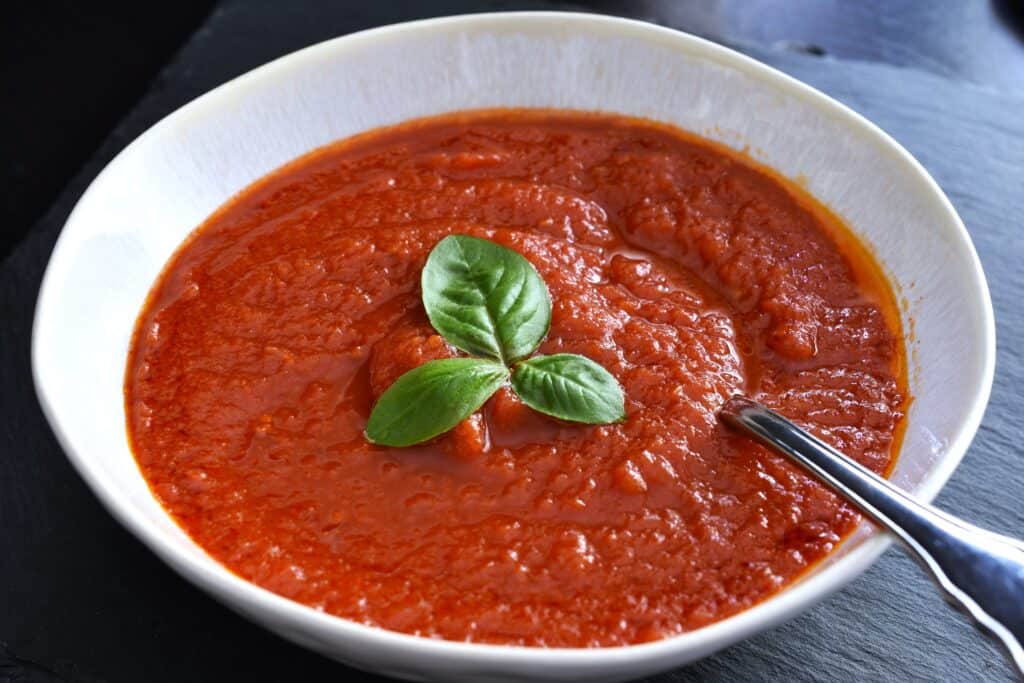



Stuffed artichokes

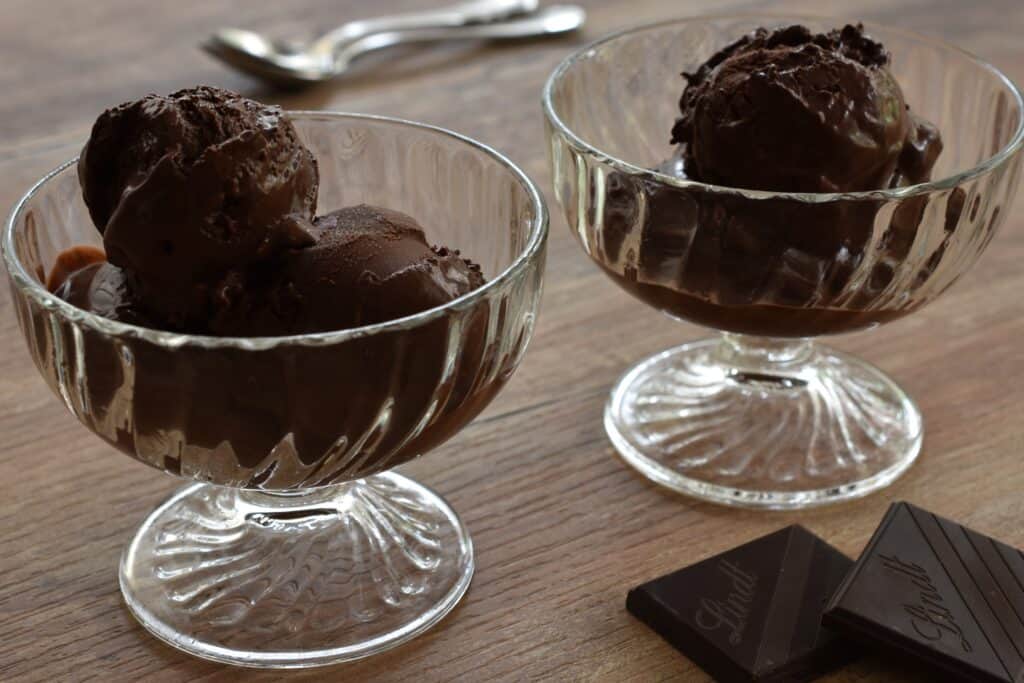
Would you like to receive my recipes as soon as I publish them? Subscribe below!








